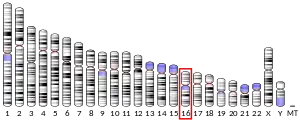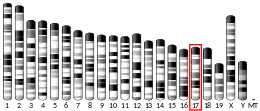| NUBP2 | |||||||||||||||||||||||||||||||||||||||||||||||||||
|---|---|---|---|---|---|---|---|---|---|---|---|---|---|---|---|---|---|---|---|---|---|---|---|---|---|---|---|---|---|---|---|---|---|---|---|---|---|---|---|---|---|---|---|---|---|---|---|---|---|---|---|
.svg.png.webp) | |||||||||||||||||||||||||||||||||||||||||||||||||||
| Identifiers | |||||||||||||||||||||||||||||||||||||||||||||||||||
| Aliases | NUBP2, CFD1, NBP 2, NUBP1, nucleotide binding protein 2, CIAO6, NUBP iron-sulfur cluster assembly factor 2, cytosolic | ||||||||||||||||||||||||||||||||||||||||||||||||||
| External IDs | OMIM: 610779 MGI: 1347072 HomoloGene: 8057 GeneCards: NUBP2 | ||||||||||||||||||||||||||||||||||||||||||||||||||
| |||||||||||||||||||||||||||||||||||||||||||||||||||
| |||||||||||||||||||||||||||||||||||||||||||||||||||
| |||||||||||||||||||||||||||||||||||||||||||||||||||
| |||||||||||||||||||||||||||||||||||||||||||||||||||
| |||||||||||||||||||||||||||||||||||||||||||||||||||
| Wikidata | |||||||||||||||||||||||||||||||||||||||||||||||||||
| |||||||||||||||||||||||||||||||||||||||||||||||||||
| ParA/MinD ATPase like | |||||||||
|---|---|---|---|---|---|---|---|---|---|
| Identifiers | |||||||||
| Symbol | ParA | ||||||||
| Pfam | PF10609 | ||||||||
| InterPro | IPR019591 | ||||||||
| |||||||||
Nucleotide-binding protein 2 (NBP 2) also known as cytosolic Fe-S cluster assembly factor NUBP2 is a protein that in humans is encoded by the NUBP2 gene.[5]
NUBP2 is a member of the NUBP/MRP gene subfamily of ATP-binding proteins.[6] There are two types in eukaryotes NUBP1 and NUBP2, and one novel human gene that define NBP nucleotide-binding proteins (NUBP/MRP-multidrug resistance-associated protein)[5] in mammalian cells requires the maturation of cytosolic[7] iron-sulfur (Fe/S)[8] proteins as Nubp1 is involved in the formation of extramitochondrial Fe/S proteins[6] the cell division inhibitor MinD is homologous[9] and involve two proteins components of the (FeS) protein assembly machinery closely similar cytosolic[6] soluble[8] P loop[9] NTPase where Nar1[10][11] is required for assembly,[12] identified Cfd1p[13][14] in cytosolic and nuclear Fe/S protein biogenesis[8] in yeast.[15] Nubp proteins NTPase Nbp35p.[11][12] MinD is homologous to members in MinD of E. coli, a relative of the ParA family.[9][16][17]
Morphology
Further information: Morphology (biology)
NBP35 bacterial plasmids F (the classical Escherichia coli sex factor)[9] is found in all nuclear genes in vegetative and gametic flagella of the unicellular green algae C. reinhardtii and nuclear Fe/S protein biogenesis required for cytosolic iron-sulfur protein assembly; MNP =MRP-like; MRP (Multiple Resistance and pH adaptation) MRP/NBP35-like P-loop NTPase similar to; and functions as minD_arch; cell division ATPase MinD, archaeal and homologue's of NUBP1. The NBP35 gene is conserved in archaea[18] Bacteria, Metazoa, Fungi and other Eukaryotes and with considerable divergence from the yeast; Cfd1-Nbp35 Fe-S to man. In a scaffold complex[19] protein to form large molecular assemblies that store Fe(III) and 4Fe-4S seen as secondary to defects inactivated to accomplish its functions as physiologically relevant form(s) Fe/S proteins Iron regulatory protein 1 (IRP1) is regulated through[14] prevents deficiencies and increased mutation rates[17] that characterized a plant P loop NTPase with sequence similarity to Nbp35 homologue's of NUBP1.[20]
Interactions
NUBP2 has been shown to interact with...
- ACO1 Iron-responsive element-binding protein 1 (IRE-BP 1) (Iron regulatory protein 1) (IRP1)[14][21]
- MAPK8IP3 C-jun-amino-terminal kinase-interacting protein 3 (JNK-interacting protein 3) (JIP-3)[22]
- IGFALS Insulin-like growth factor-binding protein complex acid labile chain precursor (ALS)[22][23]
- KIF11 Kinesin-like protein KIF11 (Kinesin-related motor protein Eg5)[24]
- SEPP1 Selenoprotein P precursor (SeP)[17]
- CA1 Carbonic anhydrase 1 (EC 4.2.1.1) (Carbonic anhydrase I) (Carbonate dehydratase I) (CA-I)[16][17][20]
References
- 1 2 3 GRCh38: Ensembl release 89: ENSG00000095906 - Ensembl, May 2017
- 1 2 3 GRCm38: Ensembl release 89: ENSMUSG00000039183 - Ensembl, May 2017
- ↑ "Human PubMed Reference:". National Center for Biotechnology Information, U.S. National Library of Medicine.
- ↑ "Mouse PubMed Reference:". National Center for Biotechnology Information, U.S. National Library of Medicine.
- 1 2 Nakashima H, Grahovac MJ, Mazzarella R, et al. (1999). "Two novel mouse genes--Nubp2, mapped to the t-complex on chromosome 17, and Nubp1, mapped to chromosome 16--establish a new gene family of nucleotide-binding proteins in eukaryotes". Genomics. 60 (2): 152–60. doi:10.1006/geno.1999.5898. PMID 10486206.
- 1 2 3 Stehling O, Netz DJ, Niggemeyer B, et al. (2008). "Human Nbp35 is essential for both cytosolic iron-sulfur protein assembly and iron homeostasis". Mol. Cell. Biol. 28 (17): 5517–28. doi:10.1128/MCB.00545-08. PMC 2519719. PMID 18573874.
- ↑ Netz DJ, Pierik AJ, Stümpfig M, Mühlenhoff U, Lill R (2007). "The Cfd1-Nbp35 complex acts as a scaffold for iron-sulfur protein assembly in the yeast cytosol". Nat Chem Biol. 3 (5): 278–86. doi:10.1038/nchembio872. PMID 17401378.
- 1 2 3 Hausmann A, Aguilar Netz DJ, Balk J, Pierik AJ, Mühlenhoff U, Lill R (2005). "The eukaryotic P-loop NTPase Nbp35: an essential component of the cytosolic and nuclear iron-sulfur protein assembly machinery". Proc Natl Acad Sci U S A. 102 (9): 3266–71. Bibcode:2005PNAS..102.3266H. doi:10.1073/pnas.0406447102. PMC 552912. PMID 15728363.
- 1 2 3 4 Motallebi-Veshareh M, Rouch DA, Thomas CM (1990). "A family of ATPases involved in active partitioning of diverse bacterial plasmids". Mol. Microbiol. 4 (9): 1455–63. doi:10.1111/j.1365-2958.1990.tb02056.x. PMID 2149583. S2CID 40829252.
- ↑ Balk J, Aguilar Netz DJ, Tepper K, Pierik AJ, Lill R (2005). "The essential WD40 protein Cia1 is involved in a late step of cytosolic and nuclear iron-sulfur protein assembly". Mol Cell Biol. 25 (24): 10833–41. doi:10.1128/MCB.25.24.10833-10841.2005. PMC 1316972. PMID 16314508.
- 1 2 Rutherford JC, Ojeda L, Balk J, Mühlenhoff U, Lill R, Winge DR (2005). "Activation of the iron regulon by the yeast Aft1/Aft2 transcription factors depends on mitochondrial but not cytosolic iron-sulfur protein biogenesis". J Biol Chem. 280 (11): 10135–40. doi:10.1074/jbc.M413731200. PMID 15649888. Archived from the original on 2012-03-12. Retrieved 2010-12-23.
- 1 2 Balk J, Pierik AJ, Aguilar Netz DJ, Mühlenhoff U, Lill R (2005). "Nar1p, a conserved eukaryotic protein with similarity to Fe-only hydrogenases, functions in cytosolic iron-sulphur protein biogenesis". Biochem Soc Trans. 33 (Pt.1): 86–9. doi:10.1042/BST0330086. PMID 15667273. Archived from the original on 2012-03-12. Retrieved 2010-12-23.
- ↑ Yarunin A, Panse VG, Petfalski E, Dez C, Tollervey D, Hurt EC (2005). "Functional link between ribosome formation and biogenesis of iron-sulfur proteins". EMBO J. 24 (3): 580–8. doi:10.1038/sj.emboj.7600540. PMC 548649. PMID 15660135.
- 1 2 3 Roy A, Solodovnikova N, Nicholson T, et al. (2003). "A novel eukaryotic factor for cytosolic Fe-S cluster assembly". EMBO J. 22 (18): 4826–35. doi:10.1093/emboj/cdg455. PMC 212722. PMID 12970194.
- ↑ Okuno T, Yamabayashi H, Kogure K (2010). "Comparison of intracellular localization of Nubp1 and Nubp2 using GFP fusion proteins". Mol Biol Rep. 37 (3): 1165–8. doi:10.1007/s11033-009-9477-7. PMID 19263241. S2CID 998955.
- 1 2 Bignell C, Thomas CM (2001). "The bacterial ParA-ParB partitioning proteins". J Biotechnol. 91 (2): 1–34. doi:10.1016/S0168-1656(01)00293-0. ISSN 0168-1656. PMID 11522360.
- 1 2 3 4 Fukushima K, Ogawa H, Takahashi K, Naito H, Funayama Y, Kitayama T, Yonezawa H, Sasaki I (2003). "Non-pathogenic bacteria modulate colonic epithelial gene expression in germ-free mice". Scand J Gastroenterol. 38 (6): 626–34. doi:10.1080/00365510310000376. ISSN 0036-5521. PMID 12825871. S2CID 25927173.
- ↑ Kohbushi H, Nakai Y, Kikuchi S, Yabe T, Hori H, Nakai M (2009). "Arabidopsis cytosolic Nbp35 homodimer can assemble both [2Fe-2S] and [4Fe-4S] clusters in two distinct domains". Biochem Biophys Res Commun. 378 (4): 810–5. doi:10.1016/j.bbrc.2008.11.138. PMID 19084504.
- ↑ Bych K, Netz DJ, Vigani G, Bill E, Lill R, Pierik AJ, Balk J (2008). "The essential cytosolic iron-sulfur protein Nbp35 acts without Cfd1 partner in the green lineage". J Biol Chem. 283 (51): 35797–804. doi:10.1074/jbc.M807303200. PMID 18957412.
- 1 2 "Entrez Gene: UniGene Hs.256549 Nucleotide binding protein 2 (MinD homolog, E. coli) (NUBP2)".
- ↑ "Entrez Gene: NUCLEOTIDE-BINDING PROTEIN 2; NUBP2 CYTOSOLIC FE-S CLUSTER DEFICIENT 1, S. CEREVISIAE, HOMOLOG OF; CFD1 Gene map locus: 16p13.3".
- 1 2 Kargul GJ, Nagaraja R, Shimada T, Grahovac MJ, Lim MK, Nakashima H, Waeltz P, Ma P, Chen E, Schlessinger D, Ko MS (2000). "Eleven densely clustered genes, six of them novel, in 176 kb of mouse t-complex DNA". Genome Res. 10 (7): 916–23. doi:10.1101/gr.10.7.916. PMC 310918. PMID 10899141.
- ↑ Sano Y, Shimada T, Nakashima H, Nicholson RH, Eliason JF, Kocarek TA, Ko MS (2001). "Random monoallelic expression of three genes clustered within 60 kb of mouse t complex genomic DNA". Genome Res. 11 (11): 1833–41. doi:10.1101/gr.194301. PMC 311134. PMID 11691847.
- ↑ Christodoulou A, Lederer CW, Surrey T, Vernos I, Santama N (2006). "Motor protein KIFC5A interacts with Nubp1 and Nubp2, and is implicated in the regulation of centrosome duplication". J Cell Sci. 119 (Pt 10): 2035–47. doi:10.1242/jcs.02922. PMID 16638812.
Further reading
- Guey LT, GarcÃa-Closas M, Murta-Nascimento C, et al. (2010). "Genetic susceptibility to distinct bladder cancer subphenotypes". Eur. Urol. 57 (2): 283–92. doi:10.1016/j.eururo.2009.08.001. PMC 3220186. PMID 19692168.
- Roy A, Solodovnikova N, Nicholson T, et al. (2003). "A novel eukaryotic factor for cytosolic Fe-S cluster assembly". EMBO J. 22 (18): 4826–35. doi:10.1093/emboj/cdg455. PMC 212722. PMID 12970194.
- Gerhard DS, Wagner L, Feingold EA, et al. (2004). "The status, quality, and expansion of the NIH full-length cDNA project: the Mammalian Gene Collection (MGC)". Genome Res. 14 (10B): 2121–7. doi:10.1101/gr.2596504. PMC 528928. PMID 15489334.
- Ota T, Suzuki Y, Nishikawa T, et al. (2004). "Complete sequencing and characterization of 21,243 full-length human cDNAs". Nat. Genet. 36 (1): 40–5. doi:10.1038/ng1285. PMID 14702039.
- Bonaldo MF, Lennon G, Soares MB (1996). "Normalization and subtraction: two approaches to facilitate gene discovery". Genome Res. 6 (9): 791–806. doi:10.1101/gr.6.9.791. PMID 8889548.
- Shen M, Vermeulen R, Rajaraman P, et al. (2009). "Polymorphisms in innate immunity genes and lung cancer risk in Xuanwei, China". Environ. Mol. Mutagen. 50 (4): 285–90. doi:10.1002/em.20452. PMC 2666781. PMID 19170196.
- Strausberg RL, Feingold EA, Grouse LH, et al. (2002). "Generation and initial analysis of more than 15,000 full-length human and mouse cDNA sequences". Proc. Natl. Acad. Sci. U.S.A. 99 (26): 16899–903. Bibcode:2002PNAS...9916899M. doi:10.1073/pnas.242603899. PMC 139241. PMID 12477932.
- Hosgood HD, Menashe I, He X, et al. (2009). "PTEN identified as important risk factor of chronic obstructive pulmonary disease". Respir Med. 103 (12): 1866–70. doi:10.1016/j.rmed.2009.06.016. PMC 2783799. PMID 19625176.
- Hosgood HD, Menashe I, Shen M, et al. (2008). "Pathway-based evaluation of 380 candidate genes and lung cancer susceptibility suggests the importance of the cell cycle pathway". Carcinogenesis. 29 (10): 1938–43. doi:10.1093/carcin/bgn178. PMC 2722857. PMID 18676680.



